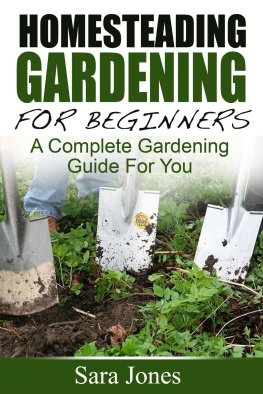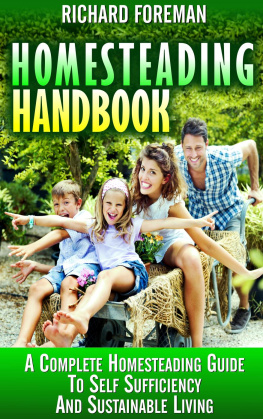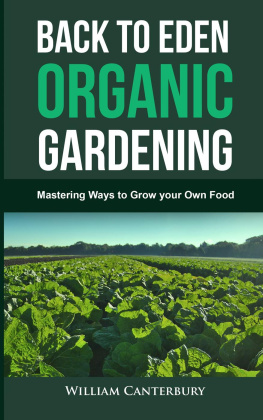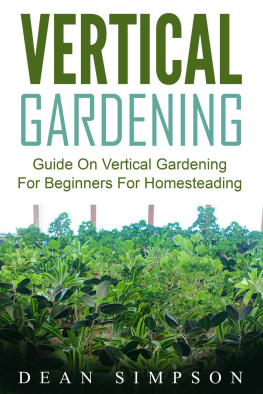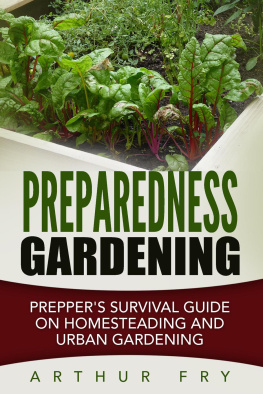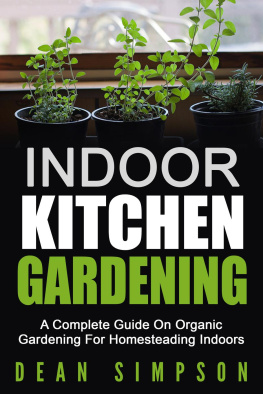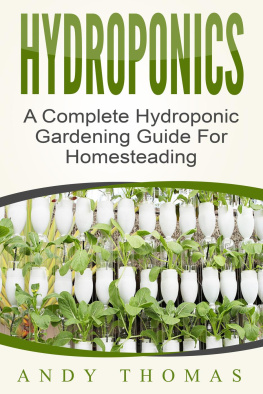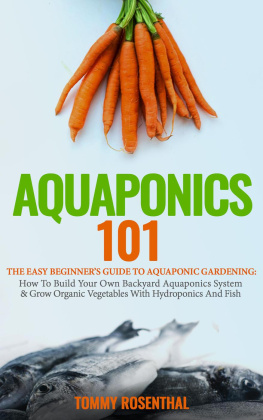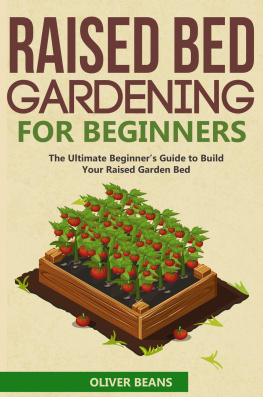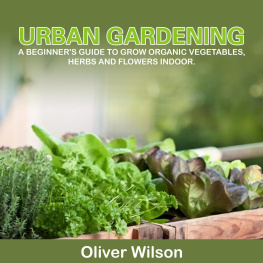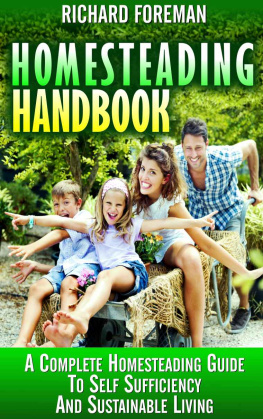Homesteading Gardening For Beginners: A Complete Gardening Guide For You
Sara Jones
Published by Sara Jones, 2015.
While every precaution has been taken in the preparation of this book, the publisher assumes no responsibility for errors or omissions, or for damages resulting from the use of the information contained herein.
HOMESTEADING GARDENING FOR BEGINNERS: A COMPLETE GARDENING GUIDE FOR YOU
First edition. August 15, 2015.
Copyright 2015 Sara Jones.
ISBN: 978-1516352142
Written by Sara Jones.
10 9 8 7 6 5 4 3 2 1
Introduction
W ith a sharp rise in the prices of consumer goods these days, will it not be great if we could save some money by growing our own produce; money that we can put to better use?
In this day and age where the DIY bug has bitten just about everybody, everything from shoes to bags to furniture is now homemade. But why should it pertain to mere arts and crafts? Why cant we diversify and start producing our own foods?
Food that we can grow in our own backyards and not have to run down to the grocery store, every time that we fall short of a tomato for the salsa.
DIY agriculture if you like, is growing your own produce at home and being self-sufficient.
In this eBook, we tell you the true meaning of Homesteading and how you can start your very own homestead garden and turn self-sufficient within a short period of time.
We also shed light on some easy to grow plants that will give you a good head start. We want to thank you for downloading this eBook and hope you enjoy homesteading as much as we had fun writing it.
Chapter 1: Meaning and Benefits of Homesteading
H omesteading is a concept wherein a person becomes self-sufficient by growing his/her own food and preserving it for future use.
It is a form of subsistence agriculture and very little produce is purchased from outside.
A few years back, after much research and hearing of the benefits that this type of a project provides, I decided to walk down the DIY agriculture path myself.
It might seem like a daunting task in the beginning but believe me; it is anything but that, once you get into doing it whole-heartedly.
Some of the advantages of homesteading are as follows:
Save money
By homesteading you can save a lot of money. You save on the money that you spend on buying vegetables and fruits and also on the taxes that are levied on them.
Grow organic
Since you yourself grow everything, you dont have to worry about harsh chemicals that are used to grow vegetables and fruits, adversely affecting your health. You can use natural fertilizers that you can make by yourself in a compost bin.
Save environment
You can do your bit for the environment by adopting homesteading. Several factories that produce fertilizers and pesticides and their products can completely damage the environment. By homesteading you can help curb that to a large extent.
Great hobby
Homesteading can prove to be extremely therapeutic and allow you to pursue your hobby. Gardening is a great hobby and helps relieve stress.
Good use of resources
When you have enough spare land, why allow it to go waste? You can start your garden just about anywhere including your front yard, backyard, terrace etc.
Chapter 2: Things You Need While Starting Out
T he basics of Homesteading involves growing food in your own garden which can be situated anywhere around your house. It can be on the terrace, on the front-yard or in the backyard.
The backyard is the most preferred area as it will make for a comfortable and private area to perform your gardening activities.
But if you live in a rented house and cannot start a garden directly in the ground then dont fret. Container gardening is a good way to start off with your homesteading experience. Large enough containers provide you with near equal results and are easier to maintain.
Things you will need:
- A piece of land with deep, rich red soil or raised beds that you can have installed in your backyard or terrace.
- Gardening tool kit which consists of 3 types of spades, a pair of vegetable pliers, a rake, a hoe, a pair of good quality rubber gloves, a wheel barrow (optional) and a hose pipe to water the plants.
- You can also have a sprinkler system installed if you cannot spend time watering the plants yourself.
- Plant seeds that you can initially buy from your local gardening store nursery and then use your own seeds to continue growing the crop.
- Natural fertilizers like coco-peat or compost.
- A trellis system (optional).
- A few bottles of Neem-oil.
For container gardens
- Containers of various sizes depending on the crop that you would like to grow and the amount of space available.
- A gardening tool kit consisting of 3 types of spades, vegetable snips, a small rake, a hoe, a pair of good quality garden gloves, a hose pipe to water or a watering jug or both.
- Plant seeds.
- Chemical free fertilizers like coco-peat or compost.
- A bottle of Neem oil.
Setting Up
S oil quality
To set up your garden, clear away all the existing plants and weeds from your garden or have raised soil beds installed.
Your soil should be an ideal mix of clay, loam and silt. If you want to be sure of its composition, you can collect a sample and give it to a local lab to determine the nutrients that are present and the ones that are missing. Depending on what is missing, you can add them to the soil yourself.
To prepare the soil, use a rake to loosen it up and water it down.
Prepare the coco-peat as per instructions and once it becomes loose and pliable, generously sprinkle it all over the garden.
For your containers, you can buy pre-soiled containers or buy your pots and soil separately.
For pre-potted containers you dont have to do much as they will already be ideally composted and you just have to sow your seeds in them.
If you are assembling then fill each pot 3/4ths of the way with a mix of soil and coco-peat.
You can also start a compost bin and put all your vegetable and fruit skins, egg shells, chicken bones etc. into it.
Use the hoe to evenly spread the coco-peat or natural fertilizer.
Choice of Crop
The choice of crop that you sow depends on your personal choice and also the conditions that prevail.
Some crops do very well in hot conditions whereas some prefer cold temperatures. So depending on the weather that prevails at your place, you can make a choice of crops.
Crops that prefer warm climate: - Squash, tomatoes, cucumbers, corn, beans and peppers.
Crops for cold climate: - Cabbage, garlic and radishes.
Blueprint
Before you start planting, you must make a blueprint of how your garden will be laid out. You cannot start before you thoroughly decide on what goes where and how to divide the garden. Once you decide, you need to bifurcate the garden as per crop needs.
For containers, you have to place similar crops next to each other and read up on which plants prefer which other plants as neighbors. For example: carrots prefer tomatoes for neighbors.
Fencing
Once you decide to bifurcate the land, you have to fence it, in order to separate it. You can set up your own fence using wooden panels or have it professionally installed. DIYS will work out to be cheaper as opposed to having someone install it.
Some plants may require trellis such as grapes and watermelons, which need to be installed in advance to help support the plant on time.
Plan out
You have to plan at least 6 months ahead of time and plan as to what to grow and how much to grow. Depending on the size of your family and your level of consumption, you have to be able to estimate as to how much crop output you will require on a monthly basis.

